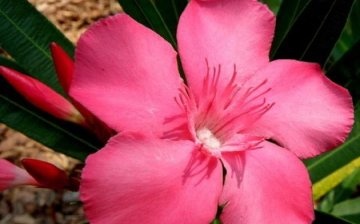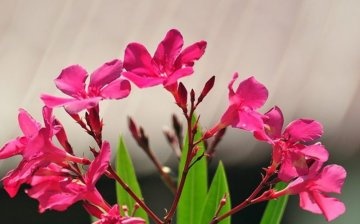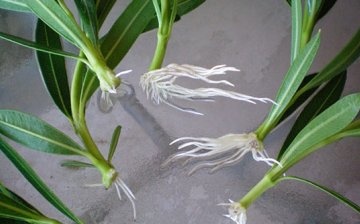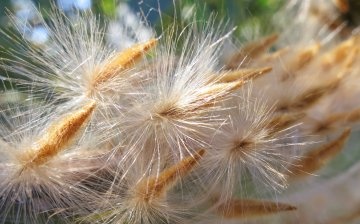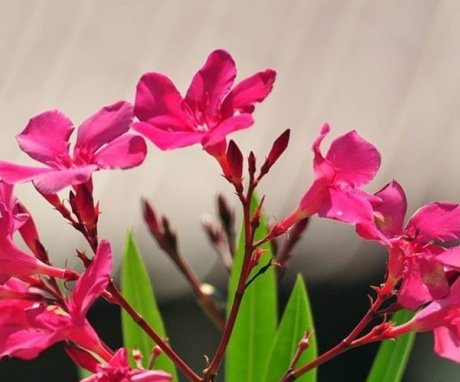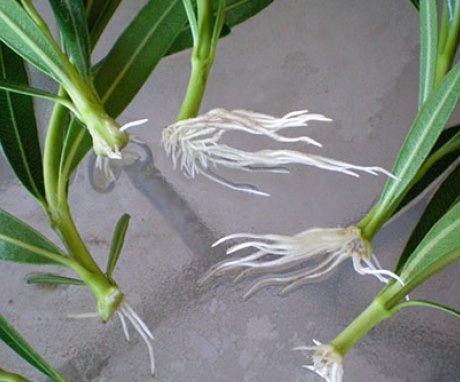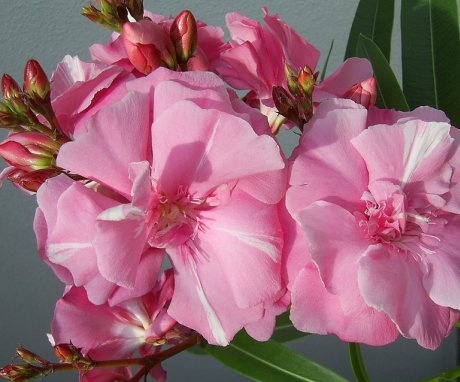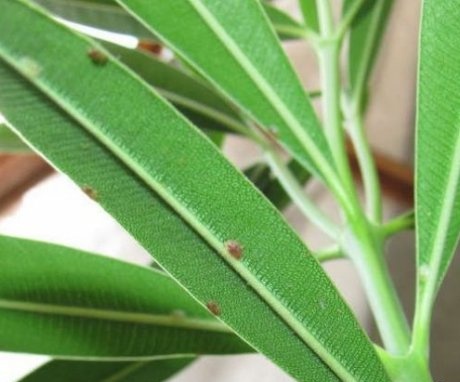Indoor oleander: growing and caring for a flower
Oleander is an extremely attractive shrub with large, wondrously smelling cyclamen-colored flowers. But despite all the attractiveness of its appearance, it is better not to place this flower in living quarters, and especially in apartments where there are children and pets.
As beautiful as the oleander is, it is just as dangerous, since almost all parts of the plant are poisonous, and the toxins persist even when the plant dries up. Even the moisture that comes from the plant is dangerous, so it is best to put such a handsome man in rooms where there is a lot of air and people are not there for too long.
Content:
- Description of the flower
- Propagation by cuttings
- Seed propagation
- How to properly care for a plant?
- Everything you need to know about a transplant
- Diseases and pests
Description of the flower
This shrub, with proper care, reaches a height of about two meters. Its stems are branching dark green with a slight brownish tinge. The leaves of the shrub are long and narrow, lanceolate, the edges are whole. In length they reach from 10 to 15 cm, and in width up to 3 cm. In the middle of the longitudinal leaf there is a light vein, and the leaf itself is attached to the branches with a short petiole.
The flowers are presented mainly in pink and white variations, but you can also find yellowish color of the petals.
The shape of the inflorescences is from simple to double. After flowering, fruits ripen on the branches, up to 10 cm in length. The plant's toxicity is due to the fact that it contains a high content of oleandrin and cornerin.
And if the sap of the plant gets inside it causes serious poisoning, passing with symptoms of colic, vomiting and diarrhea and turning into a deviation in the work of the cardiovascular system and the central nervous system, up to cardiac arrest. So it is recommended to place this plant so that contact with it is in exceptional cases and only in protective gloves and a respirator.
Propagation by cuttings
If the florist plans to start propagating his plant on his own, then this procedure must be scheduled for spring or autumn. The easiest way is to reproduce cuttingsand it also allows the daughter plant to inherit all the varietal advantages of the parent bush.
For this type, the following manipulations will be required:
- Find half-woody parts on the plant. Use a sharp knife to cut them off so that the cut area is not damaged. The length of the cutting should be approximately 15 cm.
- The cut needs to be processed fungicide and coal powder so that there is no source of infection or soil for the growth of bacteria.
- All leaf plates with petioles must be removed from the cutting, leaving only the top three leaves. But they need to be cut in half. Treat the lower end about 2.5 cm with a fungicide, and then with a preparation that will help the formation of the root system. Then the cutting is placed in good loose soil. Part of the root collar must be sprinkled with sand so that putrefactive processes do not form.
- For the next month and a half, the stalk will take root. For good root formation, a preparation for irrigation should be periodically added to the water for irrigation. root system.
- It is important to observe the temperature regime of the water, which should be about 25 C. From above, the cutting should be covered with a jar or dense transparent polyethylene, since the young plant needs high humidity and diffused light. But periodically it is necessary to ventilate the mini-greenhouse.
- You can also root the oleander in water. To do this, after all the sanitary procedures, you need to lower the stalk into the water, build a greenhouse on top, and periodically add water when it evaporates.
- When the length of the roots is about 3-3, 5 cm, the plant can be transplanted.
The cuttings with roots should be transplanted into a mixture of fine sand, charcoal and perlite. Raw materials are taken in equal proportions. Before replanting the plant, it is necessary to sterilize the soil to remove bacteria and microbes. This procedure can be done in a water bath.
Seed propagation
This method is more laborious when achieving a result, but it makes sense to study it too, since it is not always possible to grow a plant from cuttings of the mother bush:
- The most important thing is to find quality material with a high germination rate.
- On the basis of the fungicide, a solution is prepared in which the seeds are processed for half an hour. After this procedure, the seeds should be placed in a container where there will be a solution that stimulates the growth of the plant.
- The potting mix is prepared in the same way as for the cuttings.
- It is important to remember that the seeds must be placed in warm soil.
- After the seeds are placed in the soil, build small greenhouses and cover the seed containers.
- Also, the entire surface of the container must be well illuminated, for a better effect, you can use phytolamps.
- In order for the seed to have enough strength for germination and further development, the seeds should only be pressed a little into the soil and sprinkled with soil.
Oleander differs in that even with good seed quality, seedlings will not be friendly. Their hatching varies from 30 to 90 days. But as soon as the first leaves grow, then you can dive the plant.
How to properly care for a plant?
Oleander can be safely placed on the south side of the room, since the plant perfectly tolerates exposure to direct sunlight, and needs it strongly:
- In the summer months, the flower thrives at temperatures between 24 and 28 C. But in winter it is best to keep the shrub alone and in a room with a lower temperature. By the way, the abundance of fresh air is only good for the oleander, and it does not suffer from drafts at all.
- Watering for the plant must be plentiful, but the constant presence of moisture has a bad effect on the shrub. Therefore, after wetting the earthen lump well, you need to wait until the top layer dries out at least a few centimeters.
- Since the shrub does not like high humidity, the period of summer rains will suffice if it spends the warm months outdoors.
- It is worth paying special attention to the flowering period. It is imperative to introduce complex fertilizers for flowering shrubs. 1 time a month you need to apply mineral fertilizer, next month it is applied organic... Feeding the flower should start in early spring, but finish it by the end of autumn in order for the oleander to provide winter rest.
- Pinching and pruning helps the oleander maintain its decorative qualities for a long time. To create larger flowers, it is worth pinching the vegetative shoots. The main haircut is carried out in the autumn months.
Everything you need to know about a transplant
Since the oleander plant is large and abundantly flowering, the soil in which the flower grows is quickly depleted, even despite abundant feeding. Therefore, transplanting a bush must be approached responsibly.
It is worth preparing an earthen mixture for the spring transplant in the following combination in the fall:
- turf land - 1 part
- leaf land - part 1
- sand or PSG of fine fraction - 1 part
- garden land - part 1
- rotted manure - 1/2 part
- perlite
Such a mixture must be mixed well; in winter, for disinfection, you can keep it on the balcony or outside, in the garden area, but a month before the transplant, the mixture must be transferred to the house. The mixture should be thawed, saturated with air. It's worth spilling fungicides and a solution of potassium permanganate.
For young plants, transplanting is required annually.
During the procedure, you can cut off some of the roots, but this will lead to the fact that the plant will be sore for a long time and the growth of the root mass will slow down flowering. When the plant reaches adulthood, transplanting will present certain difficulties.
Then you can simply remove the top layer and add a new one, but for greater effect, you should still lay the flower on one side with outside help, remove the pot from the earthen ball and remove the old earth. Then a good drainage is placed in the planting container and the plant is placed. Then the voids are filled with soil.
Diseases and pests
A plant such as oleander has a fairly strong immunity and therefore diseases and viral infections rarely disturb him. But still it is worth understanding what dangers can await him:
- Spider mite. It manifests itself as a thin grayish cobweb in the places of internodes, while the leaves wither and sag. White specks appear on the back of the leaf blade. If you do not take any measures, then the grains merge into solid spots. Then the foliage dries and completely falls off. Especially in summer, the plant is exposed to a greater number of attacks by this parasite. You can get rid of this misfortune with the help of intensified spraying, as well as washing the places where the pest accumulates with soapy water. Then the plant should be sprayed with an anti-pest drug. And to consolidate the effect, oleander is sprayed two more times with an interval of 8-12 days.
- Mealybug - This insect has an extremely repulsive and unaesthetic appearance. It is especially good to breed in spring and autumn. Hairy small insects are especially active in assimilating young leaves and buds. They literally completely suck all the juices from the plant. You need to get rid of uninvited guests so that they do not fall into the soil. Therefore, before processing the crown, the soil layer must be covered. Further, the oleander is subjected to mechanical cleaning and washing with soapy water.
- Cancer is especially dangerous for oleander. The disease proceeds almost without symptoms, with only a slight violation of pigmentation. Small light spots appear on the leaves, which then grow. Then the shoots dry and become brittle. After some time, the plant dies, unfortunately, the disease cannot be cured.
Even an inexperienced grower can grow oleander, but it is worth remembering that this flowering shrub is quite dangerous if you do not follow safety measures.
More information can be found in the video:



